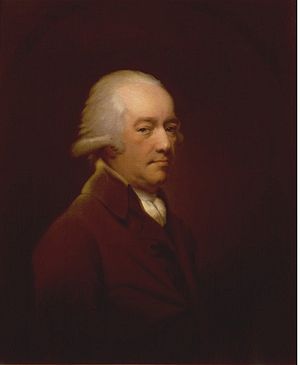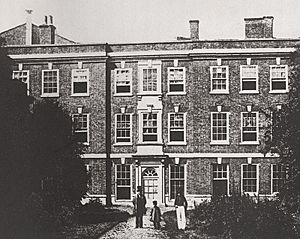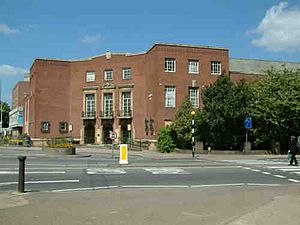Exeter House facts for kids
Exeter House was a large brick house built in the early 1600s. It was located on Full Street in Derby, England, and stood there until 1854. The house was named after the Earls of Exeter, whose family owned it until 1757. Exeter House became famous because Charles Edward Stuart, often called "Bonnie Prince Charlie," stayed there during the Jacobite rising of 1745. After the house was taken down, offices were built on the site. Later, in 1935, Charles Herbert Aslin designed the Magistrates' Courts there. These courts closed in 2004. After being empty for ten years, the building became an office space called Riverside Chambers.
Contents
Bonnie Prince Charlie's Historic Stay

This is where Charles Edward Stuart, also known as "Bonnie Prince Charlie" or "the Young Pretender," stayed. He was there from December 4 to 6, 1745. During his visit, he ate dinner with a woman named Mrs. Ward. Her son, Samuel Ward, who was born in 1732, tasted his food to make sure it was safe.
The Important Council Meeting
On the morning of December 5, a special meeting called a council of war took place at Exeter House. The leader of the prince's army, Lord George Murray, explained that they had not received enough help. They needed more support from the French and from English people who supported the Jacobite cause. Because of this, he believed they should turn back.
The prince did not want to retreat. Some members of the council also strongly disagreed with giving up their plan to march on London. However, after meeting again later that day, the prince decided to retreat. He left Exeter House the next morning. Before he left, he gave Mrs. Ward a diamond ring to thank her for her help.
The Retreat and Final Defeat
The decision to retreat meant that Bonnie Prince Charlie would not take the crown from King George II. His army returned to Scotland. They were finally defeated in 1746 at the Battle of Culloden.
Exeter House Through the Years
After the 8th Earl of Exeter died in 1754, his wife sold Exeter House in 1757. The new owner was John Bingham, who was the Mayor of Derby that year. Bingham lived in the house until he died in 1773. Later, in 1795, Jedediah Strutt bought the house. Strutt lived there until his death in 1797.
Why Exeter House Was Demolished
The last owner of Exeter House was a lawyer named William Eaton Mousely. He was also Mayor of Derby twice. In the 1830s, he made some changes to the house. However, he believed Exeter House was too big and expensive to keep up. He also wanted to make improvements to Exeter Bridge. So, in 1854, he had the house torn down. The Bingham family, who used to own the house, had built a wooden footbridge. This bridge helped them reach their gardens on the other side of the River Derwent.
The Famous Drawing Room

In 1839, Lord Stanhope visited Exeter House. He noted that the drawing room on the first floor was still the same. This was the room where the final council of war took place. He described it as "...unaltered, it is all over wainscotted with ancient oak, very dark and handsome…". 'Wainscotted' means it had wooden panels covering the walls. You reached this room by a dark oak staircase with carved railings.
Another visitor, Mrs. Thomson, said the house was set back from Full Street. It had a small, rectangular courtyard in front. A wide staircase went from a small hall up to the drawing room. On each side of the drawing room were smaller rooms with wooden panels. These rooms had been used as bedrooms for the prince and his officers. On the ground floor, there was a large drawing room (which Mousely had changed). This room led to a long garden with high walls, which went all the way down to the riverside.
Saving the Paneling
William Eaton Mousely had planned to sell the wooden panels from the house separately. However, several important people asked him not to. These included Michael Thomas Bass, who was an MP for Derby, the Earl of Chesterfield, and William Bemrose. They convinced Mousely to cancel the sales.
Instead, the wooden panels from the drawing room were moved to the cellars of the Derby Assembly Rooms. Later, when the Derby Museum and Art Gallery opened in 1879, the paneling was put back together there. In 2021, the Exeter Room display in Derby was changed. The statue of the prince was given to the Battle of Prestonpans [1745] Heritage Trust. They now display it in their Museum & Jacobite Heritage Centre at Prestonpans Town Hall.





